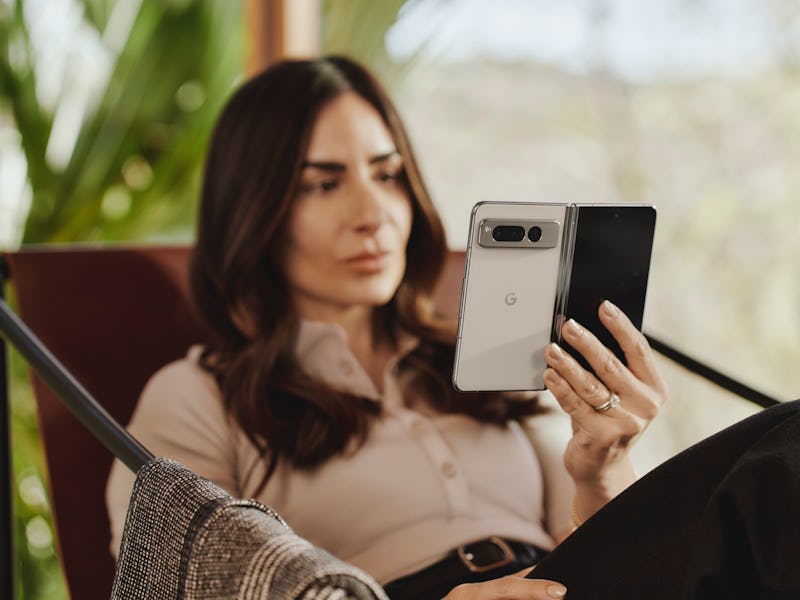Why Google’s Pixel Fold Doesn’t Play Nice With Styluses
Google's foldable can do many things, but accepting stylus input is not one of them.

Google’s Pixel Fold is a sleek piece of flagship hardware with a version of Android that seems actually bearable on a larger screen. But for everything Google’s first foldable gets right, omissions were made that stand out.
As many publications have noted, the Pixel Fold’s closest competitor in the U.S. is the Galaxy Z Fold 4, and for the same $1,799, Samsung gives you more software flexibility and more input methods on its phone-tablet-hybrid. In fact, since the introduction of the Galaxy Z Fold 3, Samsung’s largest foldable has supported the company’s S Pen stylus, something the Pixel Fold doesn’t do at all.
Speaking from experience, writing on a notebook-shaped foldable feels great, but Google may have opted out for a few reasons.
The Rigid Hinge
The hinge of the Pixel Fold is strong. Maybe too strong.
Part of Google’s improvements to the overall foldable form factor is a new “180-degree fluid friction” hinge design that lets either side of the Pixel Fold’s inside display lay flat against each other without a gap. That hinge choice has impacts across the device, potentially negative (larger bezels) and positive (no dust will get in), but Google seems to think it’s worth it to let you fold the Pixel Fold at pretty much any angle.
One disadvantage? It seems like it’s hard to fold the Pixel Fold completely flat. Because the hinge takes force to move, and generally, you don’t want to force a $1,800 device to do anything that could break it, you might notice many hands-on photos and videos outside of Google’s official ones don’t show the Pixel Fold completely flat. Michael Fisher (MrMobile on YouTube) reports the hinge is the cause. It’s possible to get the Pixel Fold completely flat; it just doesn’t feel comfortable to do.
Add in the extra bump the Pixel Fold’s camera bar adds, and you wouldn’t exactly have the flattest surface to write on if you were going to town with a stylus. It would work, sure, but it wouldn’t feel as well thought out as the other part of the device.
Fragile glass
The Galaxy Fold was frequently demoed with gloves on because of its fragile display.
Another possibility is the glass that makes the Pixel Fold possible in the first place. Foldable glass is dramatically thinner than what you’d find on a traditional smartphone and much more prone to cracks and scratches. Samsung has the receipts to prove it from the original Galaxy Fold. It’s not the kind of thing you want to take risks on with the unpredictable jabs of a stylus.
Methods for interpreting pen inputs vary. The one Google has supported the longest, which seems to be the standard across Android tablets (including the new Pixel Tablet) and Chromebooks, is USI. The Universal Stylus Initiative is an organization specifically in charge of managing the USI standard (USI 2.0 is the latest) with the promise that if you buy a USI stylus, it’ll work across devices as long as they’re USI certified.
The dream of USI 2.0 is getting something akin to the wireless charging, pressure-sensitive experience of the Apple Pencil, on a stylus you can use on more than just the iPad. The methods for accomplishing this usually require some kind of communication between the display and the pen itself, with a digitizer integrated into the display. The issue with Google’s foldable is there simply might not be enough room. Samsung had to completely redesign the Galaxy Z Fold 3 to add S Pen support in the first place, an added complication that Google might not think is worth it.
It’s possible Google wanted to include stylus support for the Pixel Fold, but deemed it an additional cost or that the extra layer would compromise its ability to claim the device as the “thinnest foldable.”
A philosophical difference
With no official pen from Google and nothing in the hardware of the Pixel Fold that suggests an active stylus could be supported later, the foldable is firmly a fingers-only device. This is a shame if only because of how popular using a stylus is on tablets. If a device has a tablet-sized screen, I don’t think it’s unreasonable to expect people would want to draw or write on it.
But more than possible hardware explanations, Google seems to have a specific perspective on foldables that’s different from Samsung's do-everything strategy. The Pixel Fold is focused and streamlined. It’s all about split-screen apps and dragging and dropping files. I wouldn’t count out a Pixel Fold with a stylus a few years from now, but for now, Google’s sticking to what works, because it wants to or has to.
This article was originally published on